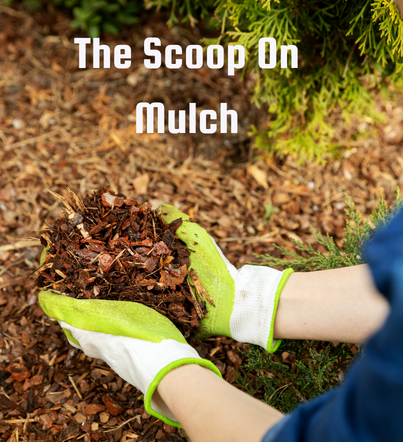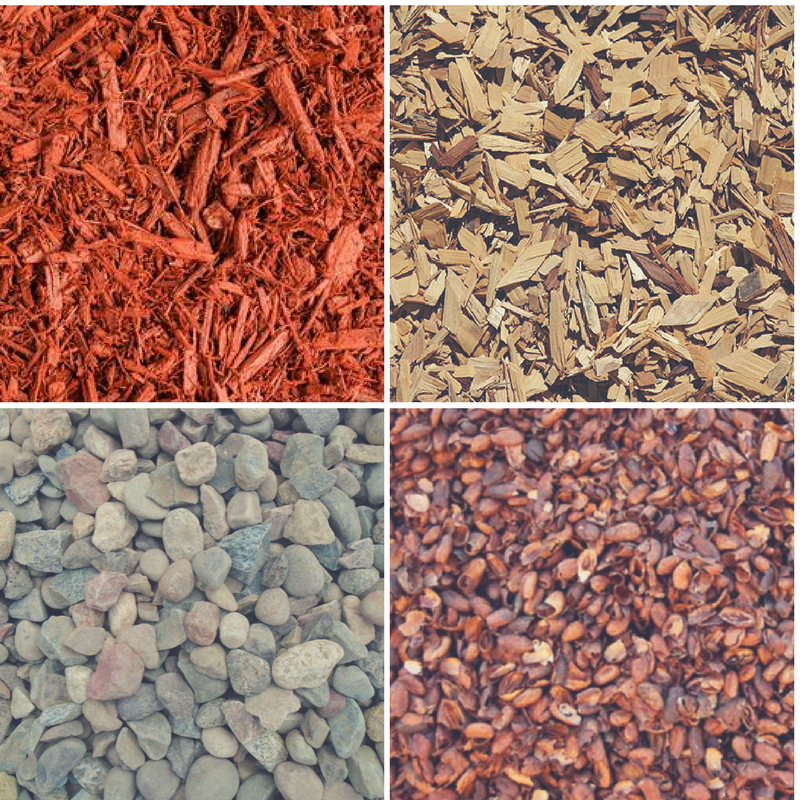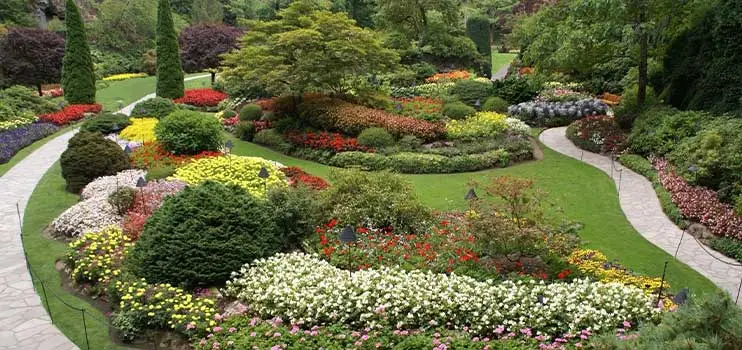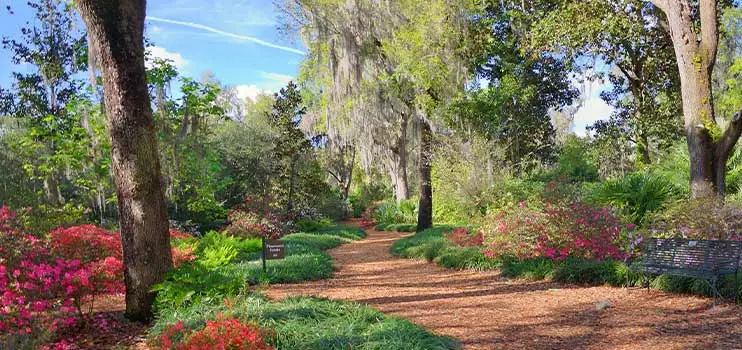What is mulch?
Mulch is a layer of material, usually organic, that is spread on top of the soil's surface to provide various benefits to the soil, plant and overall garden. Mulch can be made of many different materials, some of the most common forms are:
Woodchips and Shredded Bark
Plain old wood chips that are leftover from stump grinding or other tree work can make for a very natural looking mulch. They typically take between 1-3 years to decompose, and sometimes can compact in the process blocking water and oxygen from the roots of the plant. Another thing to note, is that when hardwood mulches break down they make soil more alkaline (raising pH), which should be taken into account when mulching around acid-loving plants. You may need to use an acid fertilizer or add sulfur to compensate.
Dyed Bark Mulch
This is the most common mulch for homeowners because of it's neat appearance and rich color way options. It is not entirely the same as straight shredded bark though, because it generally has non organic material mixed in and will not decompose and nourish your plants like plain old shredded bark will.
Compost
If you want a mulch that adds loads of nutrition and organic matter to your plants than you should consider composting. It takes about one year to decompose, and is a very economical and environmentally conscious mulch option. Even if you don't do your own composting at home, many municipalities have started to compost and give it back to local residents for free or a minimal charge. Compost can also make for a great additive to soil or alternate mulch material.
Cocoa Hull Mulch
This is not only one of the better looking mulch options with it's rich deep color, sniff sniff, it also carries with it a smooth and sweet chocolatey scent. Although it is one of the pricier options, it has a very slow decomposition rate and it's fine texture make it very hard to blow away. One thing to note, cocoa mulch is proven to be poisonous to dogs and cats. The caffeine level is such that if a dog consumes as little as 6 ounces it could be lethal.
Stones and Pebbles
Landscape stones come in a variety of different shapes, colors and sizes and provide a more formal polished look to a garden. The main pros are that they are long lasting (forever!) and do a fantastic job at blocking weeds. One thing to consider, is that because there is no decomposition happening, your plants won't have the opportunity to absorb the additional beneficial nutrients as they do with organic mulch. Also, they come with a high price tag and are heavier and result in a higher installation cost.
What are the benefits of Mulching?
Mulching provides many benefits to your plants, shrubs, trees and perennials. Some of the top reasons we give people for mulching included:
- It discourages the growth of weeds
- Organic mulches decompose and feed your plants/trees beneficial nutrients
- They retain moisture and allow it to be absorbed slowly over time
- They act as a blanket, protecting roots from harsh cold and strong heat
- It improves your soil's fertility
- How about it just makes your landscape look better?
Tchukki Anderson, BCMA, CTSP* and staff arborist with the Tree Care Industry Association says:
"Trees with mulched root zones are usually larger, healthier, develop faster and have higher rate of survival than plants surrounded by turf grass or bare dirt. Mulches retain soil moisture and nutrients and reduce erosion and soil compaction."
While many people choose to lay mulch in the spring as they prep their gardens for the summer, Fall in fact is one of the most beneficial times of year to lay mulch. It will help nourish and hydrate your trees throughout the winter and will provide warmth to the soil and roots.
Good mulching
How Wide is Wide? A good mulch bed should extend out at least three feet from a tree’s trunk in all directions, though extending out to the dripline is preferred. This is where the fine, absorbing tree roots extend out into the soil, and mulch provides many health-related benefits for those roots. Keep all mulches several inches away from the base of the tree to avoid rot and diseases.
How Deep is Deep? The mulch bed depth should be maintained at 2 to 4 inches.
Go Ahead, Cover the Grass! If there is grass in the area that needs to be mulched, put a five-page layer of newspaper over the grass, get it wet, then add mulch on top (this will help keep the grass from growing up through the mulch).
Use the Right Mulch. For poor soils, use well-composted mulch to build up the nutrients. Soils that are healthy will do fine with a highly stable softwood bark (such as cypress bark), which doesn’t break down as easily.
Measure the pH content. Checking the pH content of the mulch ensures it is compatible with the tree and soil.
Bad mulching
• No Volcanoes, Please! The biggest no-no when mulching is to create a “mulch volcano” that is piled high around the base of the tree. This practice traps moisture around the tree trunk and root flare leading to decay and, eventually, structural failure.
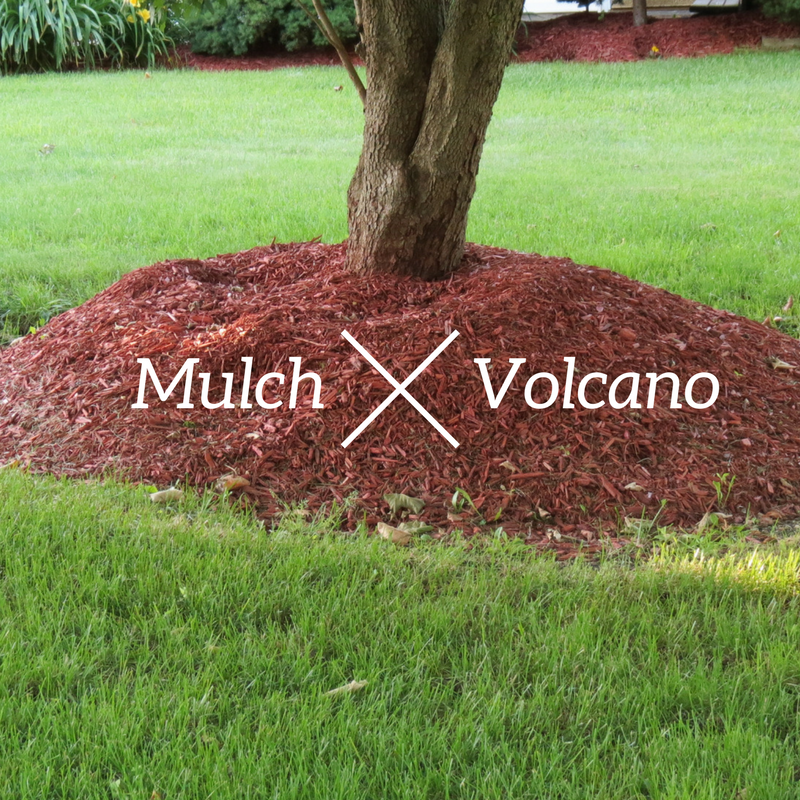
• Avoid Fine Mulch. Thick blankets of fine mulch can become matted and prevent the penetration of water and air.
• Don’t Let Mulch Sour. Low oxygen levels (from packed mulch) creates a toxic “sour” mulch – which may give off pungent odors. Even worse, the compounds produced during the souring process (methanol and acetic acid) can kill young plants.
• Don’t Keep Adding New Mulch on Top of the Old. While mulch does decompose, you do not want to accumulate excessive mulch year after year by adding fresh mulch every spring. If you want the look of fresh mulch, break up the old with a rake, and only add a layer of new on top if there is less than 4 inches in depth.
Emerald Tree and Shrub Care
For more information on tree care or to schedule a consultation with one of our master arborists please call us at 914-725-0441 or email us at info@emeraldtreecare.com

